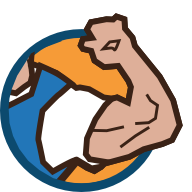Is Losing Muscle on a Calorie Deficit Inevitable?
Most Popular Calculators

For most people, when they say they want to lose weight, they really mean they want to lose body fat, not muscle mass. We know that losing some muscle is possible on a cut, even inevitable if you are on a large calorie deficit.
But how inevitable is it really? And if it’s not inevitable, what determines if we lose, keep or even put muscle on while cutting?
Before we answer that question, we need to learn more about what happens when you lose weight…
Losing weight with a calorie deficit
A calorie deficit occurs when you consume fewer calories than your body needs to maintain its current weight. This number of maintenance calories is called your TDEE (total daily energy expenditure).
You can use our calorie calculator to estimate how many calories you should consume to achieve your weight loss goal.
If you consume less than your TDEE, your body will have an energy shortfall, forcing it to convert stored fat into energy. Fat is your body’s primary energy reserve, but in long term or aggressive calorie deficits, your body will lose muscle mass, too.
Calorie deficits can be achieved through diet alone. But, combining diet with an increase in physical activity can help create a more sustainable and healthier weight loss plan.
Regular exercise not only burns calories during your workouts, but it also increases your resting metabolic rate in the 48 hours after exercising. This means your body continues to burn calories after you’ve stopped exercising.
What powers your body?
Your body needs a continuous supply of energy to power it’s various metabolic processes. That includes the growth of new tissue (including muscles), generating heat to maintain body temperature and the “kinetic” activities of muscle contractions.
We’re not going to get too deep into the science, but you can think of there being three sources of energy your body uses:
1) Glycogen
When you eat carbohydrates, your body turns that macronutrient into glucose (hence the spike in blood glucose levels after you eat). This is the most efficient source of energy for your cells and it can be used up very quickly by your muscles and brain.
Your body converts excess glucose into glycogen, which is stored in your muscles and liver. Your glycogen stores get used up in 12-24 hours, so it’s important to keep eating carbs to keep enough energy supplied!
2) Fats
Fats are much more energy dense than carbs and protein, storing 9 calories of energy per gram, compared to just 4 calories per gram for protein or carbs.
Importantly, fats can be stored in your adipose tissue (“body fat”) beneath your skin and around your organs. This provides your body a longer-term store of energy - on the order of months compared to just hours and days for carbs.
3) Proteins
Protein is perhaps better thought of as building blocks for your muscles, organs and other body tissues, rather than an energy source per se. Proteins are made up of amino acids. There are 20 types of amino acid found in proteins in the human body.
Although your body prefers glycogen and fat as energy sources for its immediate and longer term energy needs, it is technically true that your body can use protein for energy by breaking down the amino acids into glucose. It will only do this as a last resort.
Do we burn muscle for energy?
Some argue that if you maintain a large calorie deficit, your body will “burn” muscle to provide additional energy.
It is true that your body can break down muscle tissue into amino acids, then glucose, which will provide an additional source of energy. This process is called catabolism.
Catabolism is an important survival mechanism, which we’ve inherited. In times where food wasn’t so abundant, this mechanism kept our ancestors alive through famines and droughts.
A 2015 study compared the effect of rapid weight loss and gradual weight loss on myostatin and follistatin, two proteins in the blood associated with muscle breakdown. A process called the "myostatin/activin signaling pathway" can trigger the breakdown ("catabolism") of muscle in the body, and this study looked at blood markers that indicate this activity.
The study didn't find a difference in most blood markers, but those who lost weight rapidly had more myostatin and less follistatin in their blood, which could indicate the early stages of muscle breakdown.
Ah, so… if you’ve got a calorie deficit, you’re going to lose muscle, right? Your body “burns” the muscle for extra energy, right?
Is it really for energy?
There’s a slight problem with the survival theory. After all, even if you have a rather large deficit (up to 2 lbs per week), your body should have ample reserves of glycogen and body fat to fuel your cells.
If catabolism is a last resort, why is your body taking the dramatic action of destroying muscle cells to unlock a rather inefficient source of energy?
There is another reason your body is keen to get rid of muscle, and it’s less to do with your body needing energy right now…
One of the “downsides” of muscle is that it uses lots of energy just to maintain it. Even when your muscles aren’t active, they are continuously burning calories.
You’ve probably heard that increasing your muscle mass increases your metabolism. And it’s absolutely true… your basal metabolic rate goes UP when you build new muscle.
From a weight loss and strength training perspective, this is great!
But, your body is trying to maintain an equilibrium at all times. You’ve built new muscle, which uses lots of energy to maintain, and at the same time pushed your body into an energy shortfall…
Your body’s response? Let’s get rid of that muscle, we don’t need it!
Use it or lose it
So can you stop your body from destroying muscle? Yes and no.
If you’re on a large deficit (2 lbs per week), it’s almost inevitable you’ll lose some muscle. That’s one reason why we recommend losing weight gradually rather than rapidly.
But, even if you are on a modest deficit losing say 1 lb per week, you can still lose muscle.
The only way you can avoid losing muscle is by doing some resistance training while you lose weight. Resistance training promotes the growth of muscle, increases metabolic rate and increases bone density.
Doing regular resistance training tells your body you do need that muscle, after all. Or it simply offsets the muscle you are losing.
Either way, it doesn’t really matter, if you don’t use it, you lose it.
Proteins and macros
To maintain or grow muscle mass while losing weight, it's important that you consume enough protein in your diet.
Protein is a key macronutrient involved in the growth and repair of muscle tissue. A protein intake of between 1.2 g and 1.6 g per kg of bodyweight should be sufficient for most people.
Balancing your macronutrients is important when cutting calories. You need to make sure you are getting a sufficient amount of carbohydrates, fats and proteins to fuel your body.
The standard ratio is 50% carbohydrates, 30% fats and 20% protein, but this might not provide enough protein if you have a large calorie deficit.
You can use a macro calculator to get a custom recommendation. This calculator takes into account your height, age, gender, activity level, as well as your current weight and weight goal.
Workout plans to lose weight
- 90 day workout plan - Our 90 day workout plan is a great way to get in shape for the new year. This plan is suitable for beginners, and includes exercises that target the whole body. The workout plan has 3 stages, featuring compound bodybuilding exercises, fat-burning cardio and individual body part muscle chiseling. And it takes just 30 minutes per day!
- Workout routine for women - Our workout routine for women targets your arms, thighs, and abdomen. It also incorporates high-intensity interval training (HIIT), strength training and flexibility exercises.
- 3 day full body workout - Our full body workout routine consists of 3 training sessions per week that see you work all your major muscle groups in each session. Full body workouts are an effective way to build and strengthen your chest, back, shoulders, arms, legs and core. This style of strength training is not only a great way to build muscle but, combined with cardio exercises, can improve your overall fitness and health.

